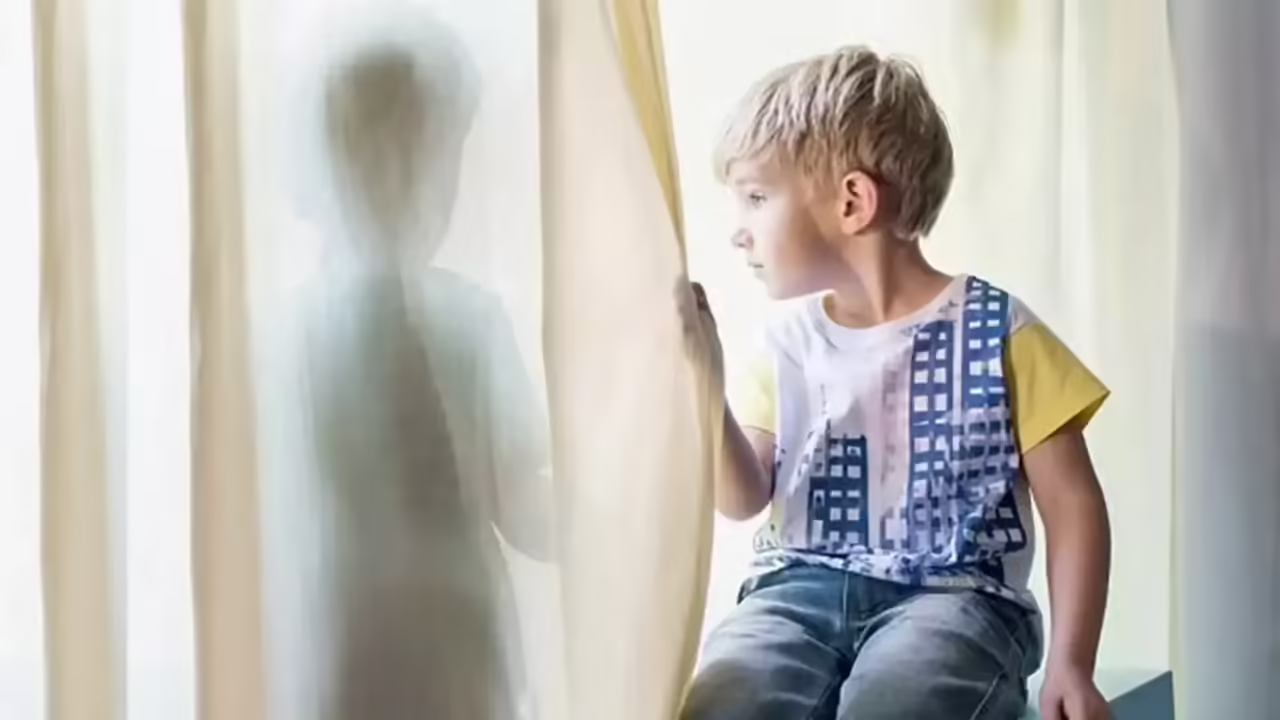
A fundamental aspect of the human being when he is still in the first years of life, is that he enjoys a formidable imagination. Some metaphysicians say that this imagination is clairvoyant thanks to the fact that the soul has not been corrupted yet, that is why it would be that the children of young age manifest to see angels, strange beings and speak with them.
Several cases are registered in all times and cultures. However, it is not only a matter of angels, because apparently they also perceive evil entities, according to some terrifying accounts of children who have entered into a paranormal friendship with some kind of entity. Let’s see:
The ghost of the woman in red
In a village in Oaxaca, Martha got the scare of her life when her little brother began to tell her about a woman dressed in red who appeared in her room at night. The boy told her that her name was Fanny and that she would float in at night to bless him.
But curiously, Martha remembered that a relative who had died long ago had the same name and her favorite color was red. She found a photograph in a trunk of memories and was surprised when the five-year-old boy recognized it. As if that wasn’t enough, he said he also saw a guy named Jacob who slept next to Martha every night.
The pirate from beyond the grave
At a school in Texas, they were amazed by the experience of one of the children and his family. Daniel’s father, Ramon Juarez, was terrified when he told his 7-year-old son’s school board about the sinister things he said at home. Things like seeing a ghost he called “the captain”, who he described as having a long white beard and who insinuated that when he grew up, his mission would be to assassinate many people under his direction.
Things got worse when Daniel, tormented by his supposed imaginary friend, wept bitterly because he said he had no intention of ever killing anyone, but “the captain” insisted that he would get used to it. He was taken to a psychologist, but tests showed that the boy was in excellent mental condition.
Angels of dubious provenance
Max, a 5-year-old boy, has already accustomed his family to hearing him talk to his imaginary friends. Max claims that he talks to angels all the time. And indeed, his conversation with these supposed invisible beings takes place every moment. Both at school and at home they suspected that he might be suffering from some psychiatric condition, but he was tested and his mental health is optimal. What is serious is not that he claims to talk to entities from other dimensions, but that one day his mother heard him say to one of the alleged angels: “… but he is my only father, I cannot kill him even if you ask me to”.
Grandfather’s ghost
This happened in Seattle, USA. Little Margareth had been telling her parents for days about her paranormal encounters with a transparent man who would enter her room every night and cross her eyes. As the girl told the same story every day, her mother decided to investigate the ghost’s features. When Margareth described him, they suspected that he was her grandfather, who had died 15 years earlier. When they looked at a family photo album, the little girl recognized him and it was one of the most shocking moments in that family.
“The devil is on his way.”
That was what a little girl of only 3 years old said, when her mother entered the room and found her talking alone as usual, with her two imaginary friends that a few months ago began to appear to her and she called them: Dee Dee and Dodo. When she was surprised by her mom, she made to hang up the toy phone, stared coldly at her and with complete certainty exclaimed, “Shhh the devil is on his way”.
“Don’t say my name!”
Little Kathy was no exception to the children who claim to see and engage in direct communication with people invisible to others. The odd thing was that her family continually asked her for the name of that imaginary friend, to which she steadfastly refused. One day when she was playing locked in her room, her siblings sneaked up to spy on her. In those moments she was playing with that imaginary friend and great was their impression, when Kathy called him by name and left them petrified: the name of her friend was: Lucifer.
People who know about paranormal phenomena and metaphysical matters, consider a phrase that since ancient times, is famous among occultists: “For the wise, to imagine is to see and create”.
Children’s imaginary friends are a common and normal phenomenon that can occur in childhood. These friends are figures invented by children, often imaginary characters with whom children play and share experiences. Although they may be seen as a sign of loneliness or even mental disorder by some adults, child development experts emphasize that imaginary friends are a healthy way for children to explore and express their thoughts and emotions.
Imaginary friends often appear during preschool and early childhood and usually disappear as the child grows and develops. Most children invent them before age 7, and although they are not as common in adolescence, some youth and adults may still have imaginary friends.
There are many theories as to why children create imaginary friends. Some experts believe it is a way for them to process and understand the world around them, while others believe it is a way to meet their emotional and social needs. For example, a child who lacks real friends at school may create an imaginary friend to play with and share their thoughts and feelings. It can also be a way to address fears and anxieties, such as talking to an imaginary friend before bedtime can help a child feel more secure and calm.
In addition, imaginary friends can be a way to explore identity and self-awareness. Children can use imaginary friends to experiment with different personalities and roles, which helps them discover who they are and what they like. It can also be a way to develop their creativity and imagination skills.
While imaginary friends are generally a normal and healthy aspect of child development, it is important to keep in mind that in some cases, they can be a sign of underlying problems. For example, if a child is overly dependent on their imaginary friend or if their imaginary friend becomes obsessive or controlling, it may be a sign of anxiety or autism spectrum disorders.
In general, parents and caregivers can support children who have imaginary friends by accepting them and allowing them to play and explore with them. They can also foster a child’s social and emotional development by providing opportunities to interact with other children and adults.
In addition to being a healthy way for children to explore and express their thoughts and emotions, imaginary friends can also be a valuable tool for children’s learning and education. For example, children can play with their imaginary friends to practice social and emotional skills, such as resolving conflicts and expressing their feelings. They can also be a way to teach values and lessons to children, as they can create imaginary situations in which children can learn about friendship, honesty and responsibility.
Another important aspect of imaginary friends is that they can be a way to improve self-esteem and confidence in children. Children can feel more secure and confident when they have a friend to play with and share their thoughts and feelings with. This can help them develop greater self-esteem and self-confidence, which is essential for their emotional and social growth.
It is important to keep in mind that imaginary friends are a normal and healthy aspect of child development, but can be difficult for adults to understand. Parents and caregivers should try to be understanding and not judge children for having imaginary friends, and instead, should be supportive and encourage their development.
In addition to being a healthy way for children to explore and express their thoughts and emotions, imaginary friends can also be a valuable tool for children’s learning and education. For example, children can play with their imaginary friends to practice social and emotional skills, such as resolving conflicts and expressing their feelings. They can also be a way to teach values and lessons to children, as they can create imaginary situations in which children can learn about friendship, honesty and responsibility.
Another important aspect of imaginary friends is that they can be a way to improve self-esteem and confidence in children. Children can feel more secure and confident when they have a friend to play with and share their thoughts and feelings with. This can help them develop greater self-esteem and self-confidence, which is essential for their emotional and social growth.
It is important to keep in mind that imaginary friends are a normal and healthy aspect of child development, but can be difficult for adults to understand. Parents and caregivers should try to be understanding and not judge children for having imaginary friends, and instead support them and encourage their development.
it is important to understand that imaginary friends can serve as a form of coping with certain situations or changes in a child’s life, such as a move to a new city, the birth of a sibling, or the loss of a loved one. In these cases, the imaginary friend can be a way for the child to process these changes and receive emotional support.
Moreover, having an imaginary friend can enhance a child’s creativity and imagination, as they are able to create a world and characters of their own. This can also help them develop social skills, as they practice communicating and interacting with their imaginary friend.
However, it is important for parents and caregivers to monitor the child’s relationship with their imaginary friend and make sure it is not affecting their behavior or ability to make real-life friends negatively. If this is the case, seeking the help of a child psychologist or family therapist can be beneficial.







